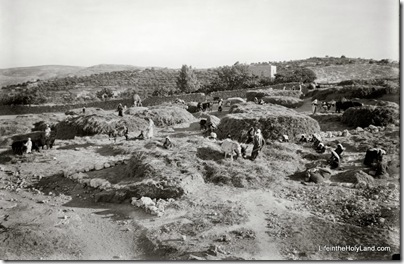“The threshing-floor is a flat place in the neighbourhood of the village. If possible, a rocky place is chosen, so that it may be easily swept. Where this is not obtainable, a hard, flat piece of ground is made to answer the purpose. The floor is common property, but each thresher keeps to a certain part of it. For four months the Fellah has nothing to fear from rain or bad weather. During that time he almost lives at the beiyâdir (threshing-floor) and some of the villages are nearly deserted, at least by the men. The wheat, &c., is spread out, and the oxen and asses are driven round so many hours a-day to tread out the grain with their hoofs, at the same time treading and softening the straw so that it becomes fit for fodder. This straw is called tibn, bundles of ordinary straw and stubble they call kash.
The animals as a rule are not muzzled” –F. A. Klein, “Life, Habits and Customs of the Fellahin of Palestine,” Palestine Exploration Fund Quarterly Statement (1883): 41-48.
“Do you suppose that these floors which we see at Yebna and elsewhere resemble those so celebrated in ancient times? They have, perhaps, changed less than almost anything else in the country. Every agricultural village and town in the land has them, and many of them are more ancient than the places whose inhabitants now use them. They have been just where they are, and exactly as they were, from a period ‘to which the memory of man runneth not to the contrary.’” –William M. Thomson, The Land and the Book (1880): 1:149-51.
The photo and quotations are taken from the Traditional Life and Customs volume of The American Colony and Eric Matson Collection (Library of Congress, LC-matpc-10182).
